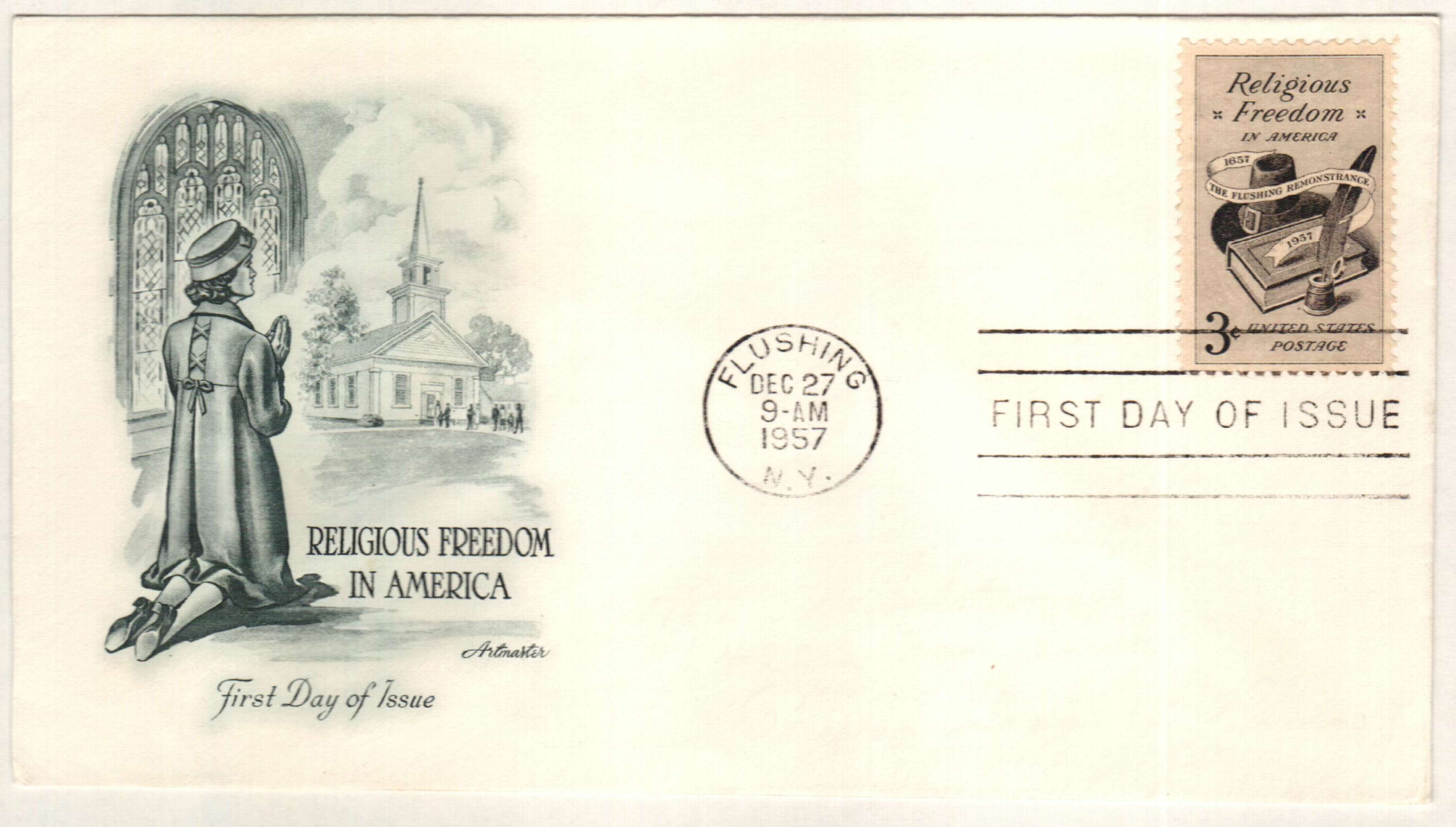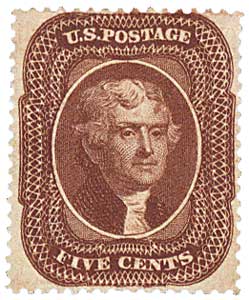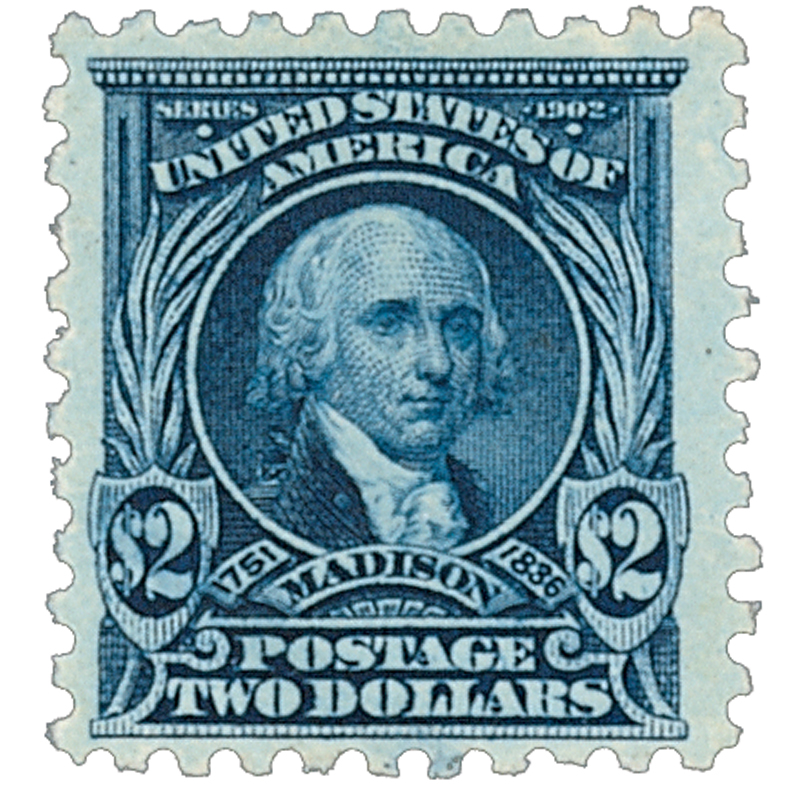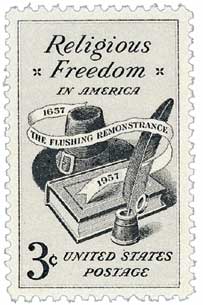
# 1099 FDC - 1957 3¢ Religious Freedom
1957 3¢ Religious Freedom
City: Flushing, New York
Quantity: 114,365,000
Printed by: Bureau of Engraving and Printing
Printing Method: Rotary Press
Perforations: 10 ½ x 11
Color: Black
Virginia Statute For Religious Freedom
Since the first British settlers arrived in Virginia in 1607, the official church of the colony had been the Church of England. Citizens were required to attend the church’s services and pay taxes to support the ministers.
The British had passed an Act of Toleration in 1689, which gave Protestants that weren’t part of the Church of England some liberties. However, they still had to pay taxes that supported the clergymen of the Church of England, and their weddings had to be performed by that church as well. Additionally, the church had a significant influence on governmental functions including relief for the poor and care of orphans. Many laws also favored Anglicans and discriminated against other religions. By the mid-1700s, those that opposed the Church of England, particularly Presbyterians and Baptists, were openly persecuted. Their ministers were jailed for disturbing the peace and preaching without licenses.

James Madison deeply opposed what was going on, and suggested to the Virginia Convention that they include “free exercise of religion” in their 1776 Declaration of Rights. However, this wasn’t specific enough to solve the major issues, namely, whether the state would have an official church and support it through taxes. Later that same year, Madison and Thomas Jefferson were part of the Committee for Religion in the House of Delegates and helped to end the religious tax on those that weren’t part of the Church of England. Many other restrictions on religious liberties were still in use, but they were reduced during the war.

In 1777, Jefferson wrote A Bill for Establishing Religious Freedom, which declared, “Our civil rights have no dependence on our religious opinions, any more than our opinions in physics or geometry.” After Jefferson was elected governor two years later, John Harvie submitted the bill to the House of Delegates. There were strong arguments for and against it, and it was eventually tabled for consideration at a later date.

As the war neared its end, Virginia’s House of Delegates was largely composed of Anglicans, and the requests by the opposition for greater religious freedom went unheard. In 1784, they passed a resolution calling for an annual tax that people would pay to their choice of church. If no church was selected, the tax would go to schools, which were largely run by the churches. Thousands of Virginians opposed the idea and sent in petitions against it. Eventually, the tax was dropped and James Madison seized the opportunity to reintroduce some older bills to change the state’s laws. Among these was Jefferson’s Statute for Religious Freedom.

There was some opposition in the General Assembly, with some trying to weaken the statute. But it was eventually passed with few changes on January 16, 1786, and signed into law three days later. Jefferson’s Act for Establishing Religious Freedom, also known as the Virginia Statute for Religious Freedom, is considered one of the most important laws ever passed by the Virginia Assembly. The statute called for the separation of church of state and granted complete religious freedom to all Virginians.
Three years later, Congress looked at the statue for inspiration when they were working on the Bill of Rights, and included the free exercise of religion in their document. Jefferson considered the statute one of his greatest accomplishments and wanted it to be included as one of just three acknowledgments on his headstone (along with the Declaration of Independence and the University of Virginia).
1957 3¢ Religious Freedom
City: Flushing, New York
Quantity: 114,365,000
Printed by: Bureau of Engraving and Printing
Printing Method: Rotary Press
Perforations: 10 ½ x 11
Color: Black
Virginia Statute For Religious Freedom
Since the first British settlers arrived in Virginia in 1607, the official church of the colony had been the Church of England. Citizens were required to attend the church’s services and pay taxes to support the ministers.
The British had passed an Act of Toleration in 1689, which gave Protestants that weren’t part of the Church of England some liberties. However, they still had to pay taxes that supported the clergymen of the Church of England, and their weddings had to be performed by that church as well. Additionally, the church had a significant influence on governmental functions including relief for the poor and care of orphans. Many laws also favored Anglicans and discriminated against other religions. By the mid-1700s, those that opposed the Church of England, particularly Presbyterians and Baptists, were openly persecuted. Their ministers were jailed for disturbing the peace and preaching without licenses.

James Madison deeply opposed what was going on, and suggested to the Virginia Convention that they include “free exercise of religion” in their 1776 Declaration of Rights. However, this wasn’t specific enough to solve the major issues, namely, whether the state would have an official church and support it through taxes. Later that same year, Madison and Thomas Jefferson were part of the Committee for Religion in the House of Delegates and helped to end the religious tax on those that weren’t part of the Church of England. Many other restrictions on religious liberties were still in use, but they were reduced during the war.

In 1777, Jefferson wrote A Bill for Establishing Religious Freedom, which declared, “Our civil rights have no dependence on our religious opinions, any more than our opinions in physics or geometry.” After Jefferson was elected governor two years later, John Harvie submitted the bill to the House of Delegates. There were strong arguments for and against it, and it was eventually tabled for consideration at a later date.

As the war neared its end, Virginia’s House of Delegates was largely composed of Anglicans, and the requests by the opposition for greater religious freedom went unheard. In 1784, they passed a resolution calling for an annual tax that people would pay to their choice of church. If no church was selected, the tax would go to schools, which were largely run by the churches. Thousands of Virginians opposed the idea and sent in petitions against it. Eventually, the tax was dropped and James Madison seized the opportunity to reintroduce some older bills to change the state’s laws. Among these was Jefferson’s Statute for Religious Freedom.

There was some opposition in the General Assembly, with some trying to weaken the statute. But it was eventually passed with few changes on January 16, 1786, and signed into law three days later. Jefferson’s Act for Establishing Religious Freedom, also known as the Virginia Statute for Religious Freedom, is considered one of the most important laws ever passed by the Virginia Assembly. The statute called for the separation of church of state and granted complete religious freedom to all Virginians.
Three years later, Congress looked at the statue for inspiration when they were working on the Bill of Rights, and included the free exercise of religion in their document. Jefferson considered the statute one of his greatest accomplishments and wanted it to be included as one of just three acknowledgments on his headstone (along with the Declaration of Independence and the University of Virginia).







